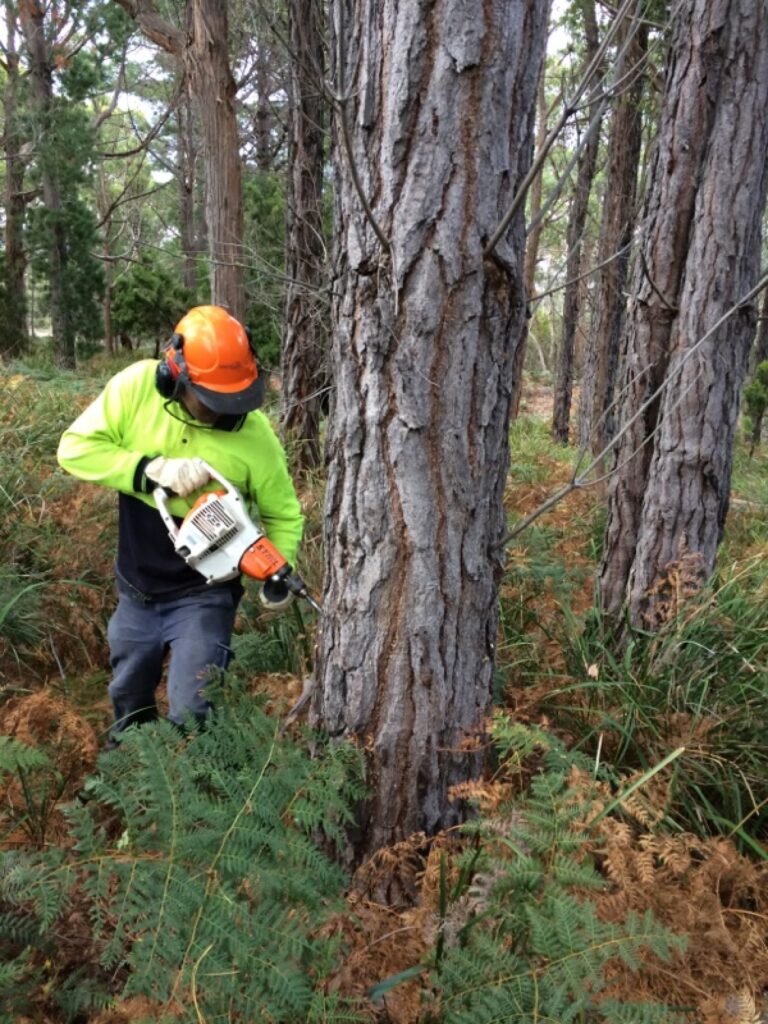The Tasmanian Land Conservancy (TLC) has partnered with Bruny Island Coastal Retreats to develop and oversee a successful radiata pine control project on south Bruny Island.
The project is believed to be the first of its kind in Australia at this scale, exemplifying the TLC’s expertise in conservation land management and powerful ability to work collaboratively.
Radiata pine germinates easily and grows quickly, making it an effective resource for the timber industry. However, in native bushlands the species has the potential to form dense copses that can override native flora, causing it to become a significant weed species.
Grid surveys from the Bruny Island project estimated that more than 100,000 pines – spanning 5 cm seedlings to 20 m trees – occurred across the 350 ha bushland property. Without any control, this rapidly expanding population of pines would have seriously impacted the condition of the bushland.
Research to identify potential control techniques that suited the requirements of the land owner were conducted by TLC Reserves Manager Denna Kingdom. These requirements included minimising the impact on the surrounding bushland; from off-target impacts of herbicide use to physical damage from falling trees, and ensuring the risk of fire was not increased because of the activities.
Pines are typically removed from former plantation sites which can be felled and rehabilitated back to native vegetation. Yet in this instance, native bushland had been overrun with pine wildlings that had seeded and developed amongst it. This made the case particularly delicate, especially given that care for the surrounding bush was a condition of the contract.
Information about applying different techniques for the project was provided by the New Zealand Department of Conservation, who had conducted similar projects in New Zealand. Subsequently, Denna determined that the best approach would employ two methods. Small trees were lopped below the first green shoot, preventing them from re-sprouting and causing death. Larger trees were poisoned with Glyphosate using a direct-drilling method that involves drilling holes every 40 cm around the circumference of the tree and applying 10 mL of undiluted herbicide per hole.

Using Glyphosate in this manner allayed the owners concerns about the use of herbicide because the direct-drilling method only affects the treated pine trees. Furthermore, while results were fast and effective – with trees visibly sick within three weeks and over 99 per cent of trees baring no green leaves within three months – trees treated with herbicide break down slowly over years, minimising physical impacts to surrounding bushland.
To determine if any trees were missed or had not died, control works for the project were carried out in two phases over three years. It was estimated that greater than 100,000 trees were controlled, with many areas previously dominated by pines now supporting native eucalypt seedlings.
Follow up surveys and controls are likely to be undertaken to ensure that any pine seedlings germinating in the future are removed, preventing the species from re-establishing. Through the commitment of the landowner and the expertise of the TLC, this land on South Bruny Island on South Bruny Island can now support a happier and healthier future.
These outstanding efforts illustrate the TLCs ongoing commitment to protecting habitats for Tasmania’s bird life, which has been further realised through the establishment of our Bird Conservation Fund. TLCs Bird Conservation Fund combines evidence-based research and ecological monitoring with direct management actions ensuring effective and long-term conservation of our birds for generations to come.

